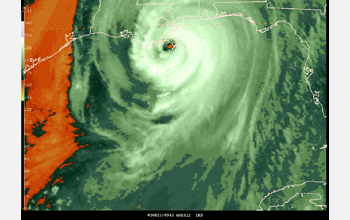Multimedia Gallery
Hurricane Katrina--Water Vapor Band
The peak winds of over 100 miles per hour that buffeted New Orleans, La., during Hurricane Katrina could have been much worse had the storm made landfall at a different moment in the cycle of its eyewall. Long-lived, intense hurricanes often go through an eyewall replacement cycle that takes a day or so to complete. The result is collapse of the main eyewall and temporary weakening of the storm. This water vapor band image shows Katrina's weakened eyewall being further disrupted by interaction with the land surface at 5:45 a.m. on Monday, Aug. 29, 2005. Jeff Weber, a University Corporation for Atmospheric Research (UCAR) scientist, generated the image using GEMPAK software and data from the water vapor and infrared bands of the National Oceanic and Atmospheric Administration's (NOAA) GOES-E (Geostationary Operational Environmental) satellite. (Further information about NOAA's GOES-E satellite is available Here.)
UCAR serves as a hub for research, education and public outreach for the atmospheric and Earth system science community. It manages the National Center for Atmospheric Research (NCAR) and the UCAR Office of Programs on behalf of the National Science Foundation and the university community. NCAR is headquartered in Boulder, Colo. For more information on UCAR and NCAR, visit the UCAR website. (Date of Image: Unknown)
Credit: Image generated by Jeff Weber; ©University Corporation for Atmospheric Research
See other images like this on your iPhone or iPad download NSF Science Zone on the Apple App Store.
Images and other media in the National Science Foundation Multimedia Gallery are available for use in print and electronic material by NSF employees, members of the media, university staff, teachers and the general public. All media in the gallery are intended for personal, educational and nonprofit/non-commercial use only.
Images credited to the National Science Foundation, a federal agency, are in the public domain. The images were created by employees of the United States Government as part of their official duties or prepared by contractors as "works for hire" for NSF. You may freely use NSF-credited images and, at your discretion, credit NSF with a "Courtesy: National Science Foundation" notation.
Additional information about general usage can be found in Conditions.
Also Available:
Download the high-resolution JPG version of the image. (871 KB)
Use your mouse to right-click (Mac users may need to Ctrl-click) the link above and choose the option that will save the file or target to your computer.

